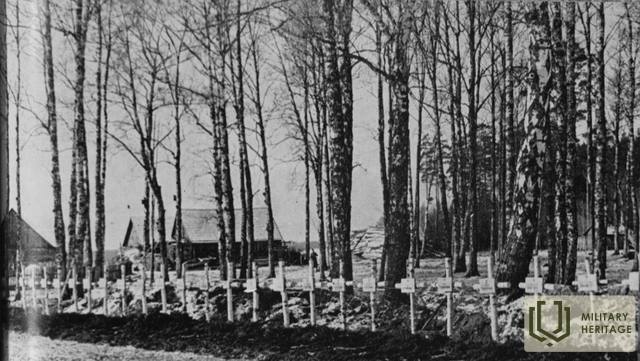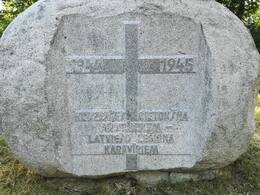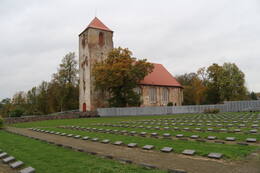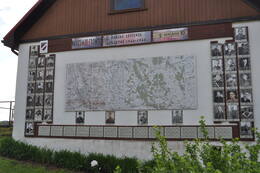Battle in Kurzeme fortress near Lestene
The narrator describes his impressions of the battles around Lestene and the role of the Latvian 19th Division in the battles.
“(..) After the five great battles, the defenders of Kurzeme believe that the heaviest is behind them, so they stand firmly in their positions so that the capitulation of Germany does not miss the opportunity to liberate the homeland.
Many suspects have returned to the units, but new fighters are still applying from both Kurzeme residents and refugees. Several thousand Latvian soldiers have also been sent from Germany for replenishment.
On March 14, I'm going to the 43rd Regiment headquarters, where I have to report. On the way I meet General Bangerski, who has arrived in Kurzeme. It seems that even the old soldier believes more than ever that a very decisive moment is approaching our country, therefore he also keeps his headquarters in Kurzeme. The general reminds me that, as a seven-time wounded man who has exhausted his fortune, I must go to him as commander. Of course, this still needs to be discussed with the division commander.
There is a stir in the regiment's headquarters. The regiment commander, Colonel Osis, leaves the regiment. Major Reinholds may appear at any moment and shall take command of the regiment. So another colonel fell at his mercy. The first for four months was Lobe.
Reinhold is finally here and takes over the regiment. I am appointed Captain Bumbier in the Battalion as Commander of the Company. The ornament is at rest and reserved at the battalion headquarters. The deputy commander of the battalion, Senior Lieutenant Jaunzems, is an old battle wolf and knows how to tell about the state of the front in detail. The Bolsheviks are in the Lestene school, where there is a good view of our location from the hill, so as soon as even the smallest group appears, they open fire on grenade launchers.
"No, it can't stay that way," we judge and look at the direction of the attack to expel the Russians from school.
Lestene itself is on the main battle line. Apart from me, there is only one other officer - Lieutenant Zutis. The number of men in the jewelry is also less than a hundred. Bolshevik speakers call every day to lay down their arms, tell about Riga. Lilita Bērziņa is speaking here, Lācis is speaking here, and another public figure is speaking here.
On the night of March 16-17, we are replaced by German units, and we are on our way to new trenches where the enemy has made an invasion. The 19th Division, if it could be said, is playing the role of a firefighter in Kurzeme - where what is happening, Latvian men must hurry up and bring order. (..)
Published in the Daugava Hawks Monthly in the USA. Lieutenant Roberts Ancāns' memories of the battles in Kurzeme "Soldier tells"
Related timeline
Related objects
Memorial Stone to Defenders of the Kurzeme Fortification
Located in Tukums region, on the side of the A9 motorway, 500 m from the turn to Lesteni in the direction of Riga.
The memorial site was established in 1991 near the Rumbu houses, in the vicinity of which there was active warfare. This is a tribute to the defenders of the "Kurzeme Fortress" who fought against the Red Army in World War II. The battles were significant because they temporarily stopped the Red Army's complete occupation of Latvia. About 300,000 Latvians emigrated, avoiding crimes against the civilian population by the Soviet regime.
At the end of World War II, a peculiar situation had developed in the territory of Latvia. There were German army forces in Kurzeme, which the Red Army tried to eliminate or prevent their involvement in the fighting in East Prussia or around Berlin. "Kurzeme Fortress" - the most common term to describe the warfare in Kurzeme from 1944 to 1945. The "battles of Kurzeme" were the battles of the German army to repel the large-scale attacks of the Red Army. The Kurzeme fortress ceased to exist shortly after the German capitulation.
Today you can see a place of remembrance and rest, which has been popular among Latvian legionnaires since the restoration of Latvia's independence.
Lestene Brothers' Cemetery
Located in Tukums region, Lestene, next to the church.
The construction of the Brothers' Cemetery in Lestene began in 1998. It is the second largest cemetery of soldiers in Latvia, where more than 1,300 Latvian legionnaires are buried together. Only after the restoration of the Republic of Latvia was it possible to bury Latvian soldiers who died in World War II from various places.
The Latvian Legion was a combat unit of the German army, formed mainly from illegally mobilized Latvians. The soldiers perceived their presence in the legion as a struggle for the restoration of Latvia's independence, despite the fact that it took place in the ranks of the German armed forces and that Germany had occupied Latvia. There was no other military force that could delay the return of the Soviet occupation. Latvian legionnaires fought against the Red Army, which had abolished Latvia's independence, destroyed its army and committed crimes against civilians. Between 110,000 and 115,000 soldiers fought in the ranks of the German army, and between 30,000 and 50,000 of them left their lives on the battlefield.
Today in Lestene you can see the Brethren's Cemetery, next to which is Lestene Church. It is an outstanding example of baroque sacred art. In the old church pub you can get acquainted with the exposition dedicated to the history of the Latvian Legion. The central image of the Brothers' Cemetery "Motherland - Mother - Latvia" was created by the sculptor Arta Dumpe. Nearby is Lestene Manor, which belonged to the Latvian Army General Mārtiņš Hartmanis before the Second World War.
Excursions to Lestene Church can be booked at the head of the parish of Lestene Evangelical Lutheran Church Inguna Kokina, phone +371 29993743.
Lestene Brothers' Cemetery, Memorial Exposition and bunker
Lestene Brothers’ Cemetery is located in Tukums municipality, Lestene, next to the Lestene church. The construction of the Brothers’ Cemetery in Lestene began in 1998. It is the second largest military cemetery in Latvia, and more than 1,300 Latvian legionnaires are buried here. Only after regaining the independence, it was possible to rebury Latvian soldiers who fell during World War II. The Latvian Legion was a combat unit of the German Army, formed mainly from illegally drafted Latvians. The soldiers thought of their presence in the legion as something that had to be done to be able to restore Latvia’s independence, despite the fact that they were in the ranks of the German armed forces and that Germany had occupied Latvia. Latvian legionnaires fought against the Red Army, which had destroyed Latvia's independence and its army and committed crimes against civilians. Between 110,000 and 115,000 soldiers fought in the ranks of the German Army and about 30,000–50,000 of them never left the battlefield. The Brothers’ Cemetery central theme ‘Motherland – Mother – Latvia’ was created by the sculptor Arta Dumpe. Across the road an exhibit dedicated to the history of the Latvian Legion has been created in a former pub. Right next to it the men of the Latvian Officers Association, under the leadership of Captain Jānis Slaidiņš, have built an underground bunker to show how soldiers and officers lived on the front lines.









